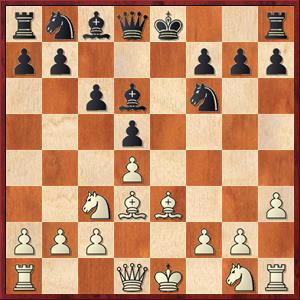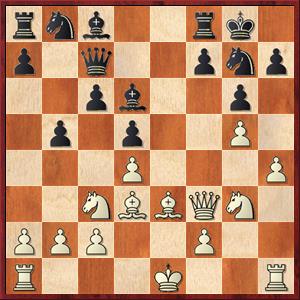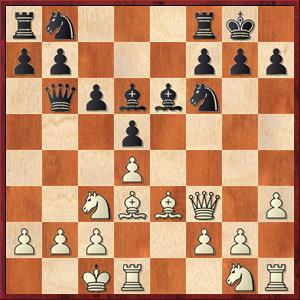Yesterday I met for a short chess session with Gjon Feinstein, Mike Splane, and Eric Montany. Mike showed us a game he played at the Kolty Chess Club last week that features a new variation he is exploring in the French. He played it against an expert named Lev (I don’t remember the last name, I’m sure Mike will fill us in) and won in very nice fashion.
I hope that it’s okay with Mike to show what he’s thinking about these days… It’s not as if we’re grandmasters who have to keep our preparation super-secret. And no one reads this blog, right? So here we go.
Mike says that everybody at the Kolty Chess Club plays the French as Black, 1. e4 e6 2. d4 d5, and he’s been playing 3. Nd2 for a long time but is getting tired of it. He decided to look for something new. He said something else that I thought was interesting. His personal record against the French is somewhere above 75 percent, with zero losses. If it was you or me, we’d say, “Why change anything? It looks as if what we’re doing is working.”
But Mike, as always, looked under the surface, and saw that even though he was winning a lot, it was not because he was getting good positions out of the opening. Even though his results were good, he thought he could do better.
So he started looking at an idea that looks crazy — not because it is so wild, but because it is so tame that nobody has ever taken it seriously before. That idea is the Exchange Variation with 3. ed ed 4. Be3?!
If you look it up on ChessBase you’ll find that this variation was played exclusively by (a) masters in the early 20th century, before opening theory had really developed, and (b) by “fish” (let’s say, players rated under 2000). This fourth move violates the spirit with which White is supposed to play the opening. He has the right to play for an initiative. The move 4. Be3 looks like a passive, defensive move that commits the bishop too early.
But Mike, as always, looked under the surface and saw that 4. Be3 is in some sense a way to transpose to the Black side of the Exchange French with a tempo up. That is, after 4. … Nf6 5. Bd3 Bd6 6. Nc3, we get a situation that usually arises with colors reversed: usually White deploys his bishop to d3 and Black replies … Nc6. Black will almost certainly play 6. … c6 and now White plays 7. h3!?, which was Bodnar’s idea.

Position after 7. h3. Black to move.
FEN: rnbqk2r/pp3ppp/2pb1n2/3p4/3P4/2NBB2P/PPP2PP1/R2QK1NR b KQkq – 0 7
White “wastes” yet another move on defense. What is the point behind this? Well, the idea is that White wants to bring his queen to f3, but if he does it right away he loses the queen: 7. Qf3?? Bg4. Oops!
In the stem game Golinka played 7. … Qc7?! (not the best) 8. Qf3 O-O? (this really castles into the attack) 9. g4 b5 (Black is trying to counter White’s kingside attack with a queenside attack, but there’s one problem — White hasn’t castled! Black’s “attack” has no target, and therefore only White has an attack.) 10. g5 Ne8 11. Nge2 g6 12. h4 Ng7 13. Ng3 (diagram).
 Position after 13. Ng3. Black to move.
Position after 13. Ng3. Black to move.
FEN: rnb2rk1/p1q2pnp/2pb2p1/1p1p2P1/3P3P/2NBBQN1/PPP2P2/R3K2R b KQ – 0 13
Mike’s comment on this position was something along the lines of: “Who wouldn’t want to play this for White every game?” All of White’s pieces are deployed actively, while Black’s queenside pieces are still undeveloped. White has a huge, risk-free attack on the kingside while Black has nothing on the queenside. White’s king can happily remain in the center until he needs to get his second rook into the attack. (I think he ended up playing Kd2 and castling by hand.)
So this is the development Mike decided he wanted to aim for. Knights on c3 and g3, bishops on d3 and e3, queen on f3, pawns on h3 and g4. To me, this variation shows all the hallmarks of Mike’s thinking, both pluses and minuses.
- Deep willingness to question established wisdom. (4. Be3)
- The variation is based not just on one move, but a whole developmental scheme that only reaches completion 9-10 moves later.
- Tricks based on transposing to positions Black would normally play, only a tempo up.
- Formation thinking — that is, deciding on move zero where your pieces are going to go.
- Few if any direct tactical threats. (After all, you can’t predict on move zero where your opponent will place his pieces.)
For what it’s worth, I disagree with some of these principles. But it’s more important, I think, that Mike is consistent with his style of chess. And let’s face it, if he gets the position he wants, he’ll have an easy game and he won’t get into time trouble the way that I always do.
Anyway, when Mike tried this for the first time in chess club, his opponent was not quite as cooperative as in the above game. Starting from the position in the first diagram, Black played 7. … Qb6. A definite improvement over 7. … Qc7 because it makes a threat. This is one way to beat a formation player: try to make threats that he has to react to. Disrupt his scheme. White has lots of possible responses to 7. … Qb6, some of them possibly quite good. In the analysis session we liked 8. a3 or perhaps even 8. Rb1; if White isn’t going to castle, why not move the rook? Nevertheless, most of White’s ways of meeting the threat of … Qxb2 do involve some change of plans.
However, Mike found an ingenious way to keep the plan going. He played 8. Qe2! I have no idea whether this is objectively best, but it is definitely psychologically best because it stays on track for his plan. Of course Black can’t take on b2 because 8. … Qxb2?? 9. Bc1+ wins the queen. The game continued 8. … Be6 9. O-O-O O-O (I may have the order of Black’s 8th and 9th moves wrong) 10. Qf3. Ta-dah! White has gotten his queen to f3 just like he wanted.
 Position after 10. Qf3. Black to move.
Position after 10. Qf3. Black to move.
FEN: rn3rk1/pp3ppp/1qpbbn2/3p4/3P4/2NBBQ1P/PPP2PP1/2KR2NR b – – 0 10
Although I may have the move order wrong, this is the gist of what happened. It may seem as if White has lost a tempo by playing Qd1-e2-f3, but he is undoubtedly going to win the tempo back, because Black’s queen on b6 is in the way of the projected pawn storm with … b5, … b4, etc. We could in fact end up in a line similar to Bodnar-Golinka, only with one huge difference. White has committed himself to castling queenside, and therefore Black does have a target for his counterattack. This makes the position much more competitive, and in fact Mike won primarily because of mistakes by his opponent later in the game.
So, was the variation a success? I’ll let you be the judge. If you like the position that White got out of this variation, perhaps a more critical test of 4. Be3 would be 4. … Bf5. This is what Eric, who has himself played the French many times, suggested. Usually the Eleventh Commandment for White is “Thou shalt punish your opponent for playing … e6 by denying him any opportunity to activate his bad bishop.” With 4. Be3 White seems to be saying, “Sure, bring your bad bishop out, I don’t care.” Can White really afford to be so easy-going? I don’t know. After 4. … Bf5 White could suddenly abandon his mild-mannered façade and play 5. g4!? “Ha! Fooled you! Now you’re going to pay!” That, however, would not be Mike Splane chess (in my opinion).
Although we were not able to reach any definite conclusion, Mike deserves credit for shaking up our assumptions on how White should play against the French Defense, and as a result we learned something new. Who could ask for more?



{ 15 comments… read them below or add one }
What doesn’t beat the French?
https://denverchess.com/games/view/5979
https://denverchess.com/games/view/5879
https://denverchess.com/games/view/89
https://denverchess.com/games/view/526
https://denverchess.com/games/view/672
https://denverchess.com/games/view/677
https://denverchess.com/games/view/724
https://denverchess.com/games/view/736
https://denverchess.com/games/view/740
Hi Brian, Love the games, especially #736 and #740. This is a variation I used to play as White and thought that nobody else in the world played it! But I played the moves in the wrong (?) order — 7. Qd2 first and then 8. dc. Also, last time I did this, after 7. Qd2 Nc6 8. dc Bxc5, instead of castling I played 9. Na4 immediately, which led after 9. … Qb4 10. Qxb4 Nxb4 to a more or less forced pawn sacrifice, 11. O-O-O. This was actually pre-game preparation; I thought that White had compensation for the pawn. But in the game I got nothing and I was very lucky to draw. That kind of discouraged me about the whole idea starting with 6. Bg5. Now I’ll take another look at it.
Also, #740 is wonderful because of the double-rook sacrifice. I’ve done plenty of queen sacs in my career, but I don’t think I have ever managed to do the classic double-rook sac. Bravo!
That is very interesting. The idea behind NOT playing the exchange is it is too likely to end in a draw, but this variation appears to be able to avoid that.
That 8 … Qxb2, 9 Bc1+ is insidious. It took me a while to understand it.
As a player of the French as black I believe the way to stop this white opening is,
first instead of 4… Nf6 I play 4… Bd6. I’m thinking that Mike might be exploiting the fact that 4 … Nf6 might be an inaccuracy. It may seem small but playing Nf6 before Bd6 allows for what Mike is doing. If the game were to continue in much the same manner with the bishop move instead of the night move then white plays 5. Nc6 then black can play 5… Qe2+. This will force some sort of concession. Probably best is 6 Ne2. But putting the knight on e2 slows white’s attack the White queen now can’t develop to e2 for f3 until the knight and king issue is resolved. So although Qe2+ might be a bit dubious and cheap it allows black time to castle and encourages white to castle king side (to avoid a pin on the knight and the dark square bishop is not yet developed).
Note that 6 Be3 to avoid the queen check is dubious. This allows blacks dark square bishop to exploit the pinned white bishop on e3 with the move 6… Bf4. The best white can do at this point is move 7. Qe2. After an exchange of bishops then an exchange of queens white is left with a backward pawn on e2 that black can exploit with an outpost on e3 and with rooks along the e file.
Let me know what you think,
Paul
Paul, I’m confused by your comment (both this and the corrected one) because … Qe7 is never a check, with Mike’s bishop already at e3. But glad you liked the post!
I’m sorry black can play 5.. Qe7+
This line reminds me of a game a friend of mine played against an expert named David Argall a couple of years ago. (Dana, you may recognize the name; Argall is the player I swindled with the queen sac that should have lost back in 2010!) The game has some similarities, namely the Qf3 and h3 moves and, of course, it’s a French Exchange.
http://www.arcadiachessclub.com/chess_game.asp?16
1 e4, e6
2 d4, d5
3 exd, exd
4 Be3, Be6 (instead of Nf6)
if 5 Nc3 then Qe7 is check.
I’m not suggesting that he would play Nc3 after Be6. But that is the point
of my response, it will deter Mikes attack. I’m guessing this, because
I play the french all the time and have not really run into anything like what
Mike cleverly came up with.
I’m guessing that 4… Be6 deters his attack because a typical response after Be6
is 5 Ne2. If they play 5 Nf3 instead then black can use the same tactic of 5… Qe7+
6 Be3, Bf4 exploiting the pin.
The correct move of 5 Ne2 by white prevents development of the Queen to f3, allowing black time to castle and prepare a defense. It also encourages white to castle king side, which will allow black better counter attacking chances.
Thanks for your feedback,
Paul
Thanks for the article, Dana. I just want to add that when considering 3. ed5, I am concerned not only about liberating Black’s queen bishop but also about granting Black equal standing in the center. Having two pawns abreast on e4, d4 is a nice asset and it’s tempting to let Black make a concession to change their status.
That said, after 3. … ed5 by Black, it seems that White must be either better or in zugzwang. Zugzwang is unlikely so it is hard to see how Gjon can ever come to sorely regret his experiment. I think he is making Black’s game simpler from a strategic point of view, but he could be making typical French Defense players uncomfortable by forcing them to play a more open position than is typical for them.
What if Black plays like White has mostly played over the millennia: (4.Be3) 4…Bd6 5.Bd3 Ne7 intending …Bf5. Now 6.Qf3!? Nbc6 7.Nc3!? when Black can bust out (in) with 7…Nb4 8.Bb5+ (note to PBP: that is what check looks like) 8…c6 9.Ba4 Bf5 10.0-0-0 Qd7 11.h3 0-0-0 or some such. Maybe 6.Qh5 Nbc6 7.c3 Be6 8.Ng3 Qd7 9.Ng3 Bg4 10.Qg5 works?
Thanks for an interesting essay on the French defense. I thought you might find it of interest that when GM Daniel Naroditsky played an exhibition match against super chess program Stockfish last summer at the Crystal Springs Uplands school in Hillsborough, CA, Stockfish did not have its opening “book” available. As a result it took most of its time on the first eight moves….and chose the French defense set up each time against Naroditsky’s Pe4. No need to ask….of course Stockfish won both games.
740 is a well known variation – I think the first 20 moves were book –
after the game Colorado Closed Champion Randy Canney told me about this
https://www.newinchess.com/Shop/ProductDetails.aspx?ProductID=1171
I tested the Jackal on dozens of patzers – none of them went for it – so apparently it takes a 2300 to be tempted by it. I was playing Lior Lapid in the Colorado Closed as well as playing Brad Lundstrom in the Colorado Senior. The extra game helped lull Lior into a false sense of security. The book trap helped me focus on my Brad game. Whipping out 20 moves instantly convinced Lior he was lost which he wasn’t.
All the details on BrianWallChess@Yahoogroups.com
Last night I played my second game with 1, e4 e6 2. d4 d5 3. ed5 ed5 4. Be3. This time I traded queens early to test White’s endgame prospects. Although I was better for the entire game, I was never able to achieve a clearly winning position. We agreed to a draw at move 47.
Afterwards I started to wonder how far back my unbeaten streak against the French went. I’ve lost my notebook covering games played between 1985 and 1991. Since late-1991 I’ve gone 26-0 with 13 draws. Prior to 1985 I was 6-0 with 1 draw. I was playing a lot of games against strong players in the 1985-91 period so it is possible I lost one or more games in that time span. I only have records of one French Defense game I played in that period and I won that one.
So, to the best of my knowledge, I have NEVER lost against the French Defense in USCF-rated games and my career record is 33-0 with 14 draws. Maybe I should stick with what is working.
Coincidentally the game that I won to achieve my Master rating was also a victory against a French.
I do remember losing twice: in a speed game against life master Jim Eade and in a simul game against expert J.L. DeJong.
I’m playing cahutcp on your site (I wish you had a subscription feed).Adding time to chess was definitely a new experience for me. I had done it before but not with anyone that had experience.Tactics, however, elude me.
FYI –
GM Serper posted an article today (1-23-2016) on chess.com about this variation of the French. He calls it the Weiss variation. Here’s a link
https://www.chess.com/article/view/an-opening-line-for-club-players
Re Eliot Winslow’s suggestion of 4. Be3 Bd6 5. Bd3 Ne7.
I think one of the points of 4. Be3 is its flexibility. 4… Bd6 s met by 5.Nc3 not 5. Bd3. Only 4… Nf6 is met by 5. Bd3, so Black would never reach the position Eliot suggested.
I am now convinced that the plan of putting the Whie queen on f3 is incorrect.
Mike